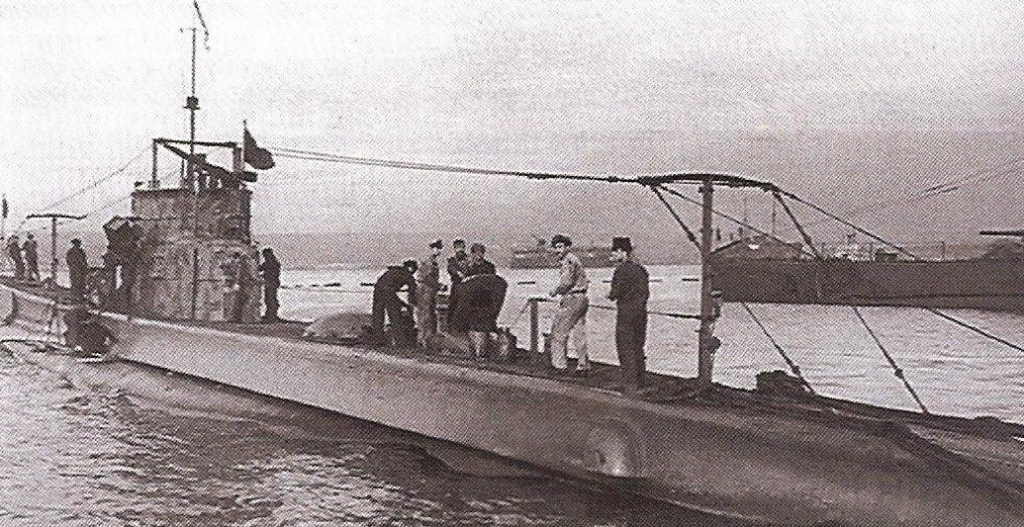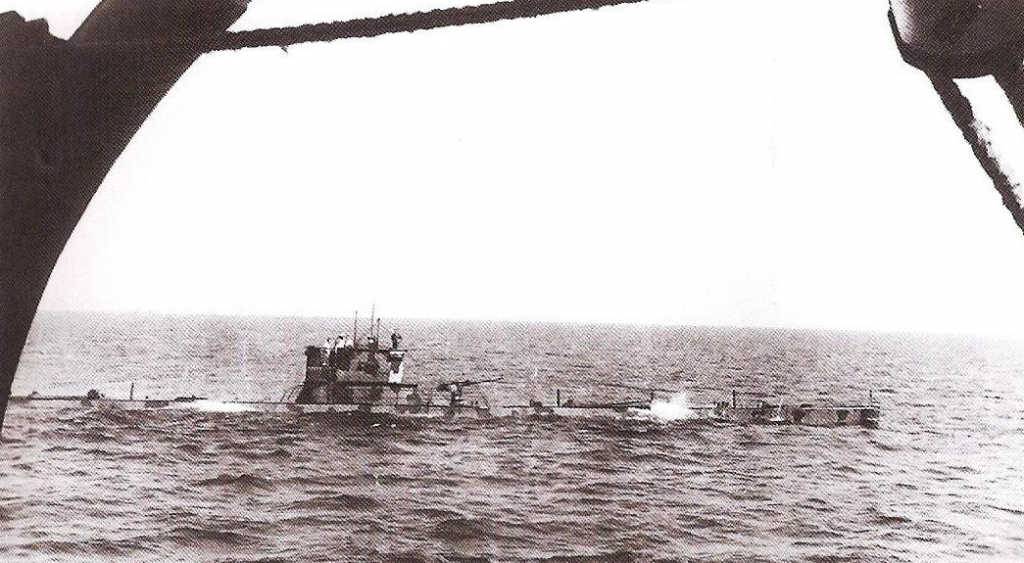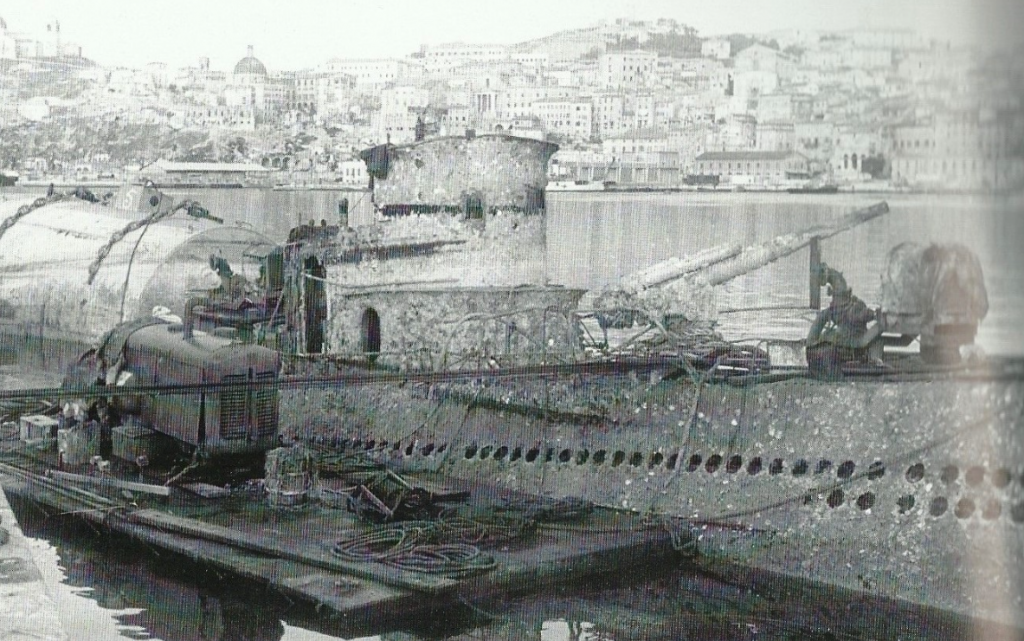The submarine Serpente was Argonauta-class coastal submarine (650 tons displacement on the surface and 800 tons submerged). The boat completed 29 war missions (17 patrols and 12 transfers), covering 11,731 miles on the surface and 2,708 submerged, and 105 training sorties.

The submarine Serpente with the camouflage used later in the conflict and the modified conning tower
Brief and Partial Chronology
April 23rd, 1930
Setting up started at the Franco Tosi shipyards in Taranto. Initially, the name chosen was Nautilus, but in 1931 it was changed to Serpente.
February 28th, 1932
Serpente was launched at the Franco Tosi shipyard in Taranto.
July 1932
During exercises and sea trials, a crew member is “forgotten” outside during the diving manoeuvre. He ended up in the water and was rescued several hours later by the submarine Luigi Settembrini. A few days later, Serpente will also hit a quay in Tarant. A few days later, its commander, Cordero di Montezemolo, was replaced.
November 12th, 1932
Entry into active service. Followed by assignment to the VIII Submarine Squadron, which the boat formed together with the submarines of the same class Salpa and the larger Luigi Settembrini and Ruggiero Settimo, also newly built.
April 25th, 1933
An explosion which occurred in a battery room while the Serpent was being repaired in Taranto, killed a civilian worker, and injured seven others.

Serpente in Taranto. In the drydock also the Destroyer Carducci
1934
Serpente made a cruise to the Balearic Islands and to some ports in Spain.
January 21st, 1935
The boat was sent from Brindisi to go to the rescue, with other units, of the French seaplane “Normandie”, ditched in the Otranto Channel due to engine failure and in prohibitive sea conditions, The plane was flying from Saigon to Marseille via Corfu and Naples. However, the intervention of the Serpent would be superfluous, as the motor ship Paganini, was closest to the scene of the accident and therefore diverted to the spot and was able to save the six occupants of the seaplane and also recover luggage and mail bags before the aircraft sank in rough seas.
1936
Deployed in Taranto, then in the Red Sea for a few months, together with her sister submarine Salpa, to verify the suitability of the Argonauta class boats to operate in those waters.
Subsequently, together with the Salpa, it was first deployed in the Aegean Sea and later in Tobruk. During this period, Lieutenant Aldo Enrici was the commander of the Serpente. Serpentyed participated, as part of a “special mission” under the command of Emilio Francardi, to the Spanish Civil War.
1938
Moved to Leros, then to Rhodes.
1939
Relocated in Tobruk.
June 10th, 1940
Upon Italy’s entry into the World War II, Serpente and her twin boat Salpa formed the XLV Submarine Squadron of the IV Grupsom, based in Taranto (according to another source, however, at the outbreak of the war the two boats were part of the Tobruk Submarine Group). Later, the Serpent was transferred to Augusta.
July 22nd, 1940
Serpente departs Taranto for a patrol in the Gulf of Solum which is aborted due to a severe breakdown with an electric motor, returning to base on the 28th.
September 19th, 1940
At 8:34 PM, 59 miles south of Morciano di Leuca, Serpente (Lieutenant Vittorio Emanuele Tognelli) launched three torpedoes against a submarine, believed to be enemy. Actually, it was an Italian boat, the Marcantonio Colonna: fortunately, it managed to avoid the torpedoes.
September 23rd, 1940
The boat went south of Crete together with the submarines Ambra and Goffredo Mameli.
October 1st, 1940
Spotted by a British formation off the coast of Crete, Serpente was damaged by destroyers with depth charges, being forced to return to base due to the damage suffered.
December 16th – 25th, 1940
The boat went to patrol, together with the submarines Dessiè and Fratelli Bandiera, in the waters around Malta.
December 20th, 1940
At 1:02 AM, Serpente (Lieutenant Commander Antonio Dotta), while on the surface (in position 35°30′ N and 16°20′ E), launched two torpedoes from less than 2,000 meters against the penultimate unit (estimated to be a light cruiser) of a formation that Dotta believed to be composed of three cruisers and a thin unit, perhaps a destroyer (these were the three cruisers that formed the protection force of the British convoy “M.W. 5” bound for Malta, located a few miles further south), 85 miles southeast of Malta.
Dotta believed that he had hit a cruiser with one or two torpedoes (having heard an explosion two minutes after launch, having dived deep to avoid the reaction). The action and the optimistic assessment of its outcome would also be reported in the war bulletin number of December 26th: “The submarine Serpente, under the command of Lieutenant Antonio Dotta, on the night between the 20th and the 21st attacked an enemy naval formation in the central Mediterranean, launching two torpedoes against a light cruiser and sinking it as was ascertained by aerial reconnaissance“.
In reality, no ships were hit (the British ships did not even realize that they have been attacked). Some sources would initially attribute (and still attribute) the sinking of the British destroyer H.M.S. Hyperion to the action of Serpente, but this unit sank due to a collision with an Italian mine (belonging to the 4 AN barrage) only two days later and at a distance of 300 miles (in position 37°40′ N and 11°31′ E).
1941
Serpente operated mainly in the western Mediterranean, in particular off Algiers and Oran.

Serpente in Cagliari with an initial attempt to a camouflage with small spots painting on the conning tower
(From “Storia Militare”)
January 12th, 1941
The boat was sent on patrol off the coast of Derna.
March 2, 1941
The boat was sent on patrol in the waters of Cyrenaica.
August 24th, 1941
Serpente was sent to lie in wait, with three other submarines, southwest of Sardinia, in opposition to the British operation “Style” (sending a convoy of supplies to Malta), forming a barrage along with Alagi, Aradam and Diaspro, but failed to detect any enemy units.
September 26th, 1941
Serpente (Lieutenant Renato Ferrini) was sent, with three other submarines (Axum, Aradam and Diaspro), to lie in a defensive ambush east of the Balearic Islands and north of Cape Bougaroni during the British operation “Halberd”, consisting of sending a convoy to Malta (military tanker Breconshire and cargo ships Ajax, City of Lincoln, City of Calcutta, Clan MacDonald, Clan Ferguson, Rowallan Castle, Imperial Star and Dunedin Star with a total cargo of 81,000 tons of supplies), but which the Italian command believed to be an attempt at a naval bombardment against the Italian coast. However, the British squadron at sea did not pass through this area, so the boat was moved further south.
September 29th, 1941
Serpent sighted, off the coast of Spain, an enemy formation consisting of a battleship escorted by four destroyers (part of Force H – battleships H.M.S. Rodney, H.M.S. Nelson and H.M.S. Prince of Wales, aircraft carriers H.M.S. Ark Royal, light cruisers H.M.S. Kenya, H.M.S. Edinburgh, H.M.S. Sheffield, H.M.S. Euryalus and H.M.S. Hermione, British destroyers H.M.S. Cossack, H.M.S. Duncan, H.M.S. Farndale, H.M.S. Foresight, H.M.S. Forestr, H.M.S. Fury, H.M.S. Gurkha, H.M.S. Heythrop, H.M.S. Laforey, H.M.S. Lance, H.M.S. Legion, H.M.S. Lightning, H.M.S. Lively, H.M.S. Oribi and H.M.S. Zulu, as well as the Polish Garland and Piorun and the Dutch Isaac Sweers – at sea for “Halberd” and precisely to cover, at a distance, convoys GM 2 and MG. 2) sailing west at 16 knots, 25 miles north-northwest of Cape Bougaroni.

Serpente in Cagliari, October 1st, 1942. On the foreground Lieutenant Renato Ferrini>
(From “Storia Militare)
Initially, the submarine maneuvers to attack the battleships, but fails due to the obstacle posed by the escort, as well as the fact that the ships proceed zigzagging. Subsequently, at 4:45 PM, Serpente launched two torpedoes from the aft tubes against one of the four destroyers (in position 37°22′ N and 06°16′ E), wrongly believing to have scored a hit (having heard a bang 50 seconds after launch, while disengaging, but this was probably due to the depth charges launched in reaction). Two of the British destroyers, H.M.S. Legion and H.M.S. Lively, spotted torpedo trails and immediately counterattacked with depth charges, but the submarine emerged unscathed from the counterattack.
October 17th, 1941
Serpente was sent on patrol north of Cap de Fer (Algeria) together with the submarines Turchese, Alagi and Diaspro.
May 4th, 1942
The boat was assigned to the Submarine School in Pula (Mariscuolasom), on behalf of which it carried out 105 training sorties, as well as some ambush missions in the Upper Adriatic. (According to another source, it was assigned to Mariscuolasom, along with the twin boats Medusa and Jalea, in 1941.)

(From ‘Storia Militare”)Serpente during a training patrol in the Upper Adriatic photographed from a corvette.
Serpente during a training patrol in the Upper Adriatic photographed from a corvette.
The armistice and the end
The armistice of September 8th, 1943, caught Serpent still in Pula, under the command of Lieutenant Commander Raffaele Allegri. The submarine was in dry dock in the Scoglio Olivi shipyard, but, unlike many other ships caught at work and sabotaged or captured due to the impossibility of being able to leave, it could be immediately put back into the water and prepared for departure.
It left Pula on September 9th. The submarine Serpent set course first for Lošinj, then Ancona, where the boat arrived at 7.39 AM on the 11th. The submarine Ametista, which had arrived a few hours earlier from Rijeka, and the pocket submarines CB 11 and CB 12 were already present in the Doric port. Serpente and Ametista were both plagued by breakdowns, which had forced them to stop in Ancona.
At 03:00 PM on September 12th, all four boats left Ancona bound for Puglia with Serpente towing CB 12, the Ametista towing CB 11. The voyage of the two larger submarines, however, ended a little further on, seven miles northeast of Numana, off Monte Conero. The commanding officers of Ametista and Serpente dropped the towlines and scuttled their boats, respectively at 5:00 PM and 5.30 PM on September 12th, 1943. The two CBs continued alone to the Tremiti, Islands from where they then reached Brindisi and Taranto.
The crew of Serpente was rescued by a fishing boat passing nearby and disembarked in Civitanova Marche. The population of Numana and Sirolo provided the survivors with dry civilian clothing.
The men who made up the crews of the two submarines, like hundreds of thousands of other soldiers in Italy and in the occupied territories, had to split up, making opposing choices. Some of them went to the North, where they enlisted in the ranks of the X Flotilla MAS of the Italian Social Republic. Others headed south, where they managed to rejoin the ranks of the Regia Marina (according to an unverifiable source of dubious reliability, the entire crew of Serpente headed north and then entered the X MAS).
Not a single man died on Serpent during three years of war, but one of its crew members did not see the end of the conflict either. Stoker sailor Antonio Giuffrida, twenty-one years old from Milan, was among the men of Serpent who became part of the X MAS of the RSI, convinced like many, that he would continue to fight against the Allies. Instead, he found himself assigned to Arona in a unit assigned to anti-partisan repression. Not intending to fight against other Italians, Giuffrida deserted and returned to Milan, but was captured by his former comrades on the tip of a spy, brought back to Arona (Novara) and shot in the courtyard of the De Filippi high school at 7:40 PM of December 5th, 1944.
At the end of the war, Commander Allegri, like the commander of Ametista Lieutenant Luigi Ginocchio, was arrested and tried by the Military Court of Genoa on charges of disobeying orders and for “loss of ship”. The sentence in the first trial, in February 1949, was six years in prison for both. In 1950 the appeal process took place, in which the lawyers highlighted the ability and valor demonstrated in war by the two commanders, and pointed out that the orders were to deliver the ships to the Allies, but also to scuttle the obsolete and inefficient ones. Disorientation caused by the confused situation of the armistice was also highlighted, which had prevented Commander Allegri from calmly evaluating what to do despite the clear orders of the Naval Command of Ancona. This led, on January 19th, 1950, to a reduction in sentence, with a suspended sentence.
While the judicial aftermath of the affair was concluded, the material existence of the two submarines in the waters of Ancona also came to a definitive end. A diver from Ancona, perhaps Elso Tonnarelli, found the wrecks at a depth of 20-25 meters, on the muddy seabed off the Conero, in an area where strong currents made diving difficult. This did not stop the recovery proposals: for Serpente, the Dorica Company for Maritime Works and Recoveries srl and the Cesare Davanzali Company joined forces. The Ancona divers Alessandro Savini and Mariano Rinaldi worked on the recovery, and later Antonio Moroni of the «Davanzali».
In the six years it had spent underwater, Serpent had progressively sunk into the muddy seabed, which had covered it for two-thirds, leaving only the bow and conning tower sticking out. The interior had also filled with mud, due to the hatches left open for scuttling, so that it had to be emptied to lighten it so that it could be lifted again. The difficulties were not few, divers, given the modest depth, began to spend long periods of time diving without adhering to the prescribed times for decompression. The Naval Command provided some lifting cylinders, but the strong storms forced the work to be postponed for month, A narrow tunnel was dug in the seabed, under the hull of the wreck, through which large chains were then passed which were then hooked to the lifting cylinders. At that point, all that remained was to fill the cylinders with air. The submarine detached from the seabed that had housed it for six years, and returned, in July 1949, to see daylight.
However, only for a short time: once recovered, the submarine was towed to the nearby port of Ancona and scrapped in 1950.

The relict of Serpente in Ancona, 1950
(From “Palombari dorici” by Luigi Borsini))
The 102/35 mm gun was returned to the Navy (which had already removed Serpent from its roster on February 27th, 1947). The sale of the lead contained in the boat’s batteries, over nine tons, yielded 8,000,000 lire (TN 624.61 ITL = $1 in 1950, equivalent to $ 165,000 in 2024) to the salvagers. Part of the steel of the hull, with a high nickel content (and whose value had risen with the outbreak of the crisis that would later lead to the Korean War), was sold to the Pieralisi Workshops in Jesi.
Original Italian text by Lorenzo Colombo adapted and translated by Cristiano D’Adamo
Operational Records
| Type | Patrols (Med.) | Patrols (Other) | NM Surface | NM Sub. | Days at Sea | NM/Day | Average Speed |
|---|---|---|---|---|---|---|---|
| Submarine – Coastal | 29 | 11,731 | 2,708 | 123 | 117.39 | 4.89 |
Actions
| Date | Time | Captain | Area | Coordinates | Convoy | Weapon | Result | Ship | Type | Tonns | Flag |
|---|---|---|---|---|---|---|---|---|---|---|---|
| 9/19/1940 | 20.34 | C.C. Antonio Dotta | Mediterranean | Santa Maria di Leuca | Torpedo | Failed | Colonna | Submarine | 880 | Italy | |
| 12/20/1940 | 01.02 | C.C. Antonio Dotta | Mediterranean | 35°30’N-16°20’E | Torpedo | Failed | H.M.S. Hyperion | Destroyer | Great Britain |
Crew Members Lost
| Last Name | First Name | Rank | Italian Rank | Date |